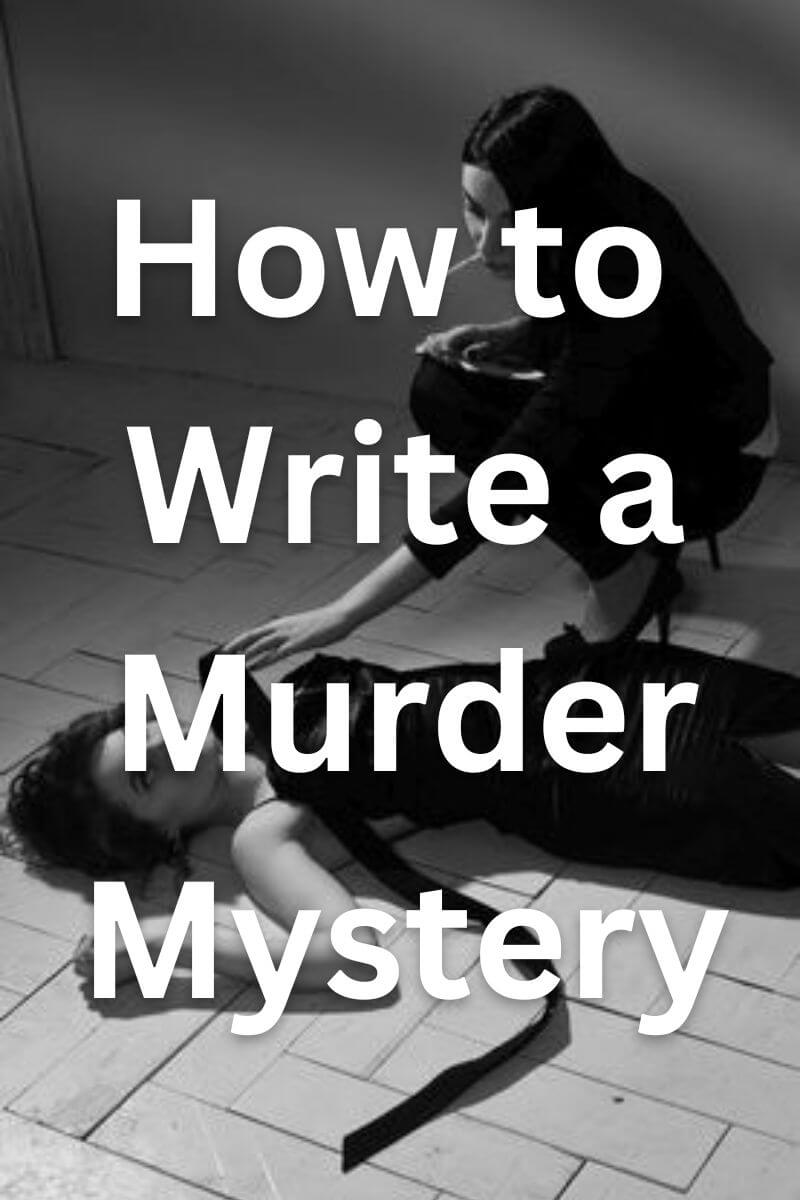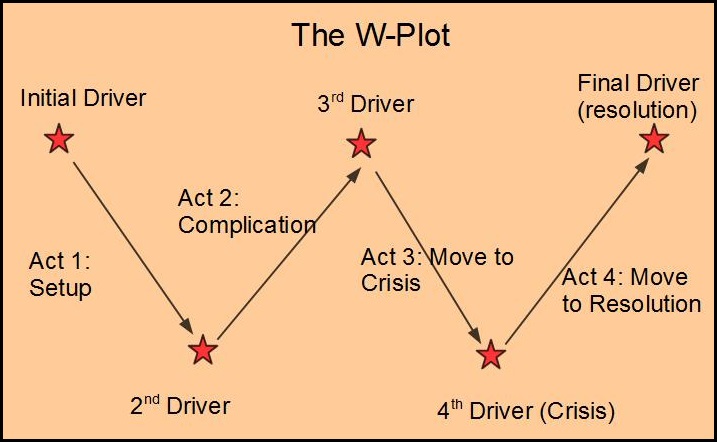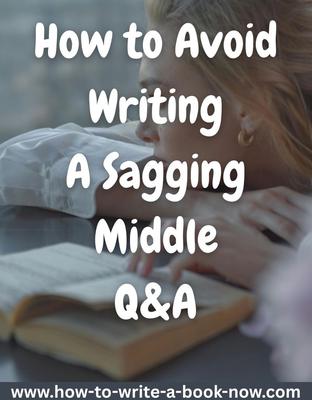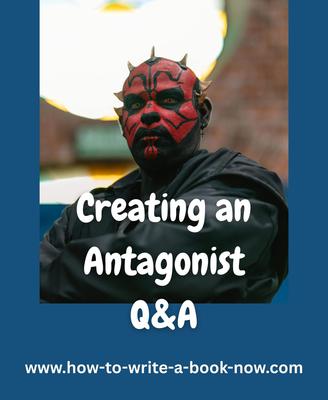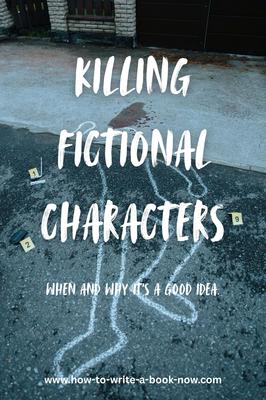How to Write a Mystery Novel
By Glen C. Strathy
Learning how to write a mystery novel is no different than learning any other literary form. You can save a lot of time and effort by first familiarizing yourself with the conventions of the genre -- the things fans expect and love about it. Then learn how to structure the story to create a compelling plot and character arc. That much I can cover in this article. (The rest -- research, imagination, and style -- you must provide.)
Since you came to this page to learn how to write a mystery, I assume you are already a fan of the genre or at least have read some great mysteries, so you are familiar with the basic things that set this genre apart. For instance, you probably already know that mystery novels concern the investigation and solving of a crime. This sets them apart from other types of crime fiction such as...
- Suspense stories: which are more about potential victims escaping a looming threat.
- Thrillers: which are generally about experts who prevent crimes before they happen.
- Capers: which are about committing crimes, and are usually told from the criminal's point of view.
A mystery novel is unique in that it is about a crime that has been successfully committed by the end of the first few chapters. The crime is almost always a murder, since that is an emotionally disturbing type of crime that begs certain questions to be answered...
- Who killed this person?
- How did they do it?
- And most important ... why did they do it?
Of these, the first is the concern of the external plot and has given these novels the nickname, "Whodunnits." The second is the basis of "locked room" and other "puzzle" mysteries that appeal to a limited readership.
The third question is most important for the majority of readers: "Why was this person killed?" Answering that question prompts an investigation and analysis of the web of dysfunctional relationships surrounding the victim and a probing of human psychology that readers find infinitely fascinating.
So, with that out of the way, let's first look at the basic rules for how to write a mystery. Then we'll consider how to structure a mystery plot....
Write a Mystery Novel in 9 Steps
1. A crime is committed.
Traditionally, the first task when you write a mystery novel is to begin with a murder. The discovery of the body does not have to happen in the first chapter, but the murder should occur by the end of the first act.
Note that it should be a real murder. If you write a mystery with a bait-and-switch, such as having the murder turn out to be a suicide or a faked death, you can disappoint or annoy readers.
If you are a plotter by nature, you may want to begin by deciding who commits the murder, how, and why before you start writing your first draft. Other writers (pantsers) may not answer these questions until they have almost finished a first draft (an approach which may require more revision later on).
2.Someone investigates the crime.
An equally important step when you write a mystery is to choose your detective. Detectives generally fall into four categories, which effectively creates four subgenres within the Mystery genre. Here are the four types...
a) Amateur: An unpaid detective who likely stumbles onto the case by accident and investigates without invitation or pay. Amateurs often rely on their understanding of people or unusual areas of expertise to solve crimes. Often these stories have less "on-page" violence.
b) Consultant: Not a professional investigator, but someone with special relevant skills or expertise who works with the police. Many television crime shows today use this type of detective.
c) Private Investigators: Often these are ex-cops who left the force due to unpleasant or even traumatic experiences. Stories about PIs tend to be darker and grittier with more violence and lower class characters than are encountered by amateur detectives.
d) Police Detectives. Police often have more resources than other detectives, such as forensics teams and laboratories. They also have the power to make arrests, get search warrants etc.
Generally, detectives in mystery novels are gifted with better than average instincts or reasoning abilities, with the exception of police detectives, who may rely more on their training and resources.
How to Write a Mystery Tip: Choosing Your Main Character
While there are cases in which the main character of a mystery novel is the detective's sidekick (e.g. Dr. Watson), the detective will usually be the main character. With that in mind, choose your detective carefully. If you are lucky enough to write a mystery series, you will have to live with your detective for a long time. So choose someone you and the reader will like and care about.
3. The crime presents a challenging puzzle for both the detective and the reader.
Easily solved crimes don't make for novel-length works. Also, readers usually like seeing a clever detective in action. They may lose respect for a one who is slow to spot an obvious solution.
Bear in mind that, while readers also like to solve the puzzles themselves, they have more respect and get more enjoyment from puzzles they fail to solve. Especially, they like solutions that only appear obvious in hindsight and they admire authors who create them.
4. The detective solves the crime by collecting evidence and testimony and analyzing it through logic.
A basic rule in all fiction is that the outcome of the story should result from the main character's actions and choices. When you write a mystery, it's important that the detective is the person who solves the crime. It can't be solved by someone else. Nor can the murderer just turn himself in.
Moreover, the detective must use logic and evidence to find the right solution. He can't solve it with a lucky guess, serendipity, ESP, or by torturing all the witnesses until one confesses. Mystery novels affirm the scientific method. Even if the detective is not a trained scientist, she must use reason and evidence to deduce the murderer's identity.
5. Readers must have all the evidence the detective does.
Since readers enjoy trying to solve the mystery themselves before the detective, you must give them a fair chance at guessing correctly. When you write a mystery, you must give the reader all the information the detective has. It is considered unfair if the detective solves the crime because of some fact that was withheld from the reader.
6. The writer tries to throw the reader and detective off the scent.
Again, if your reader and detective can figure out the correct solution right away, your novel will either be very short or very disappointing. So you must present your evidence slowly and hide it within a mass of...
- False clues (red herrings).
- Lies
- False assumptions.
- Dead ends
- Character intrigue
- Distractions
7. The detective succeeds in solving the crime by the end.
Your detective should figure out by the end who did the murder, why, and how. And the solution must be shared with the readers, otherwise they will be very disappointed.
Of course, there are exceptions, but they are rare.
8. The solution makes sense.
If you try to pass off a solution based on fuzzy logic or one that is contradicted by the evidence, readers will be very annoyed and the plausibility of your story will erode.
9. Traditional mysteries satisfy the reader's sense of justice.
Some modern, more literary mysteries may question the meaning of justice or have a more ambiguous ending. However, most mysteries satisfy the reader's sense of justice with an ending that punishes the wicked and makes the community safe again. In fact, many readers will be disappointed if that doesn't happen.
So those are the basic rules of how to write a mystery. Now let's look at how to structure your plot...
How to Write a Mystery With A Solid Plot Structure
As with all fiction, the simplest and most easy to use plot model is the W-plot. Here's what it looks like...
You'll notice it is a four-act model, with each act beginning and ending with a driver. The drivers are the major turning points in your plot. The acts are series of events in which people react to the previous driver and tension builds to the next driver.
There are two main ways you can apply this model when you write a mystery plot. I'll start with the traditional one.
How to Write a Mystery with a Traditional Opening
If you want to write a mystery with a more traditional plot, you will begin with a murder. Here's how the plot unfolds:
Initial Driver: Someone is murdered.
You can decide to show the murder or simply have the body discovered.
Act 1: Setup
The initial investigation of the crime scene occurs. The detective is called to investigate. The immediate facts and circumstances are established. An initial list of potential witnesses or suspects may be drawn. There may be an obvious but false solution presented, such as "accidental death."
2nd Driver: A discovery is made that makes the crime problematic.
Maybe the murder at first looked like an accident, suicide, or a simple "open and shut" case. However, this event reveals there is a deeper mystery that must be solved.
Act 2: Complication
The detective expands the investigation, gathering clues. chasing down leads, and interviewing witnesses. All the sordid details of the dysfunctional relationships between the victim and the people around him are revealed. The investigation broadens to include multiple suspects. It often seems as though everyone had a motive for wanting the victim dead.
3rd Driver: A second change in direction
Here something happens that makes the stakes higher or the solution more difficult. The detective may discover that he has been on the wrong track or that some larger plot is unfolding. Evidence may show the prime suspect couldn't have committed the crime. Sometimes a second murder or other crime takes place when the prime suspect has an alibi -- an event that not only signals a dead end to the current line of investigation but also creates a bigger threat (what if the murderer keeps on killing?).
Act 3: Build to Crisis
In this act, the number of suspects narrows as various possible solutions are proven to be impossible. Contradictions in the evidence or testimony show that some witnesses may be lying or some evidence may be false. The tension builds as the case seems increasingly difficult to solve.
4th Driver: Crisis
Something happens at this point that makes the case appear impossible to solve. The detective has run out of options and seems to have hit a dead end.
Act 4: Move to Resolution
Here, a new option or possibility (the real solution) is hit upon. The detective may have a flash of insight or experience a sudden breakthrough. Of course, the actual solution is not immediately revealed, even though all the evidence has been. You can tease the reader a little. But the action is now moving towards the revelation of the solution.
Final Driver: Resolution
Finally, the correct solution is revealed. In classic mysteries, this often involves gathering all the suspects together and having the detective give a speech in which he explains why most of the suspects couldn't be guilty, and then finally reveals the real murderer, who is immediately captured and brought to justice. That seems a little hokey now, as does having the murderer recite a monologue explaining why he did the crime. Nonetheless, you must reveal the solution in some manner.
How to Write a Mystery with a More Contemporary Opening
Traditional mystery novels tend to be more plot-driven, but today's readers often prefer more character-driven mysteries. They like to spend more time exploring the web of dysfunctional relationships surrounding the victim and the murderer.
To write a mystery that feels more contemporary, you will more likely choose a variation on the traditional structure, one that looks more like this...
Initial Driver
Instead of a murder, this event is more likely to be a triggering event. Something happens that causes the villain to decide to commit murder. However, the readers do not realize the significance of this event, possibly because...
a) They don't yet know the backstory, so they don't realize the event is a trigger.
b) The trigger event seems insignificant at the time.
c) The trigger event is hidden within a collage of other events.
d) The murder doesn't happen right away.
Act 1: Setup
The web of dysfunctional relationships is presented and the characters in the web are introduced in this act. There may be a lot of subtext or obvious tension between various characters, with no explanation as to why. The initial driver may be hidden within this act rather than appearing at the start. The detective's personal life may be introduced. The murder may happen in this act, but is not discovered right away and is often not shown to the reader.
2nd Driver: Discovery
The body is found, triggering the investigation.
Act 2: Complication
This is still the investigation, but now, in addition to gathering evidence, emphasis is on the detective discovering why all those relationships are dysfunctional.
After this, the structure is pretty much the same as in a traditional mystery.
Cold Cases
Another possibility is to write a mystery in which the initial driver, the first murder, happens many years before the rest of the story. You may show this as a prologue or fill the reader in on what happened at a later point. Apart from this, the rest of the structure remains much the same. The first act may show the dysfunctional relationships, resulting from the first murder. It may also show how the villain or an imitator of the first murder has taken a new victim.
How to Write a Mystery with Emotional Depth
It used to be acceptable for detectives to be somewhat aloof. That is, the drama in a mystery occurred among the other characters surrounding the victim. The detective was an objective outsider.
Today, readers are just as interested in the personal life of the detective as the victim. They want detectives who are riddled with inner conflict and wrestle with moral dilemmas. In fact, mystery readers often enjoy following the personal life of the detective throughout a career that spans several books.
So don't just write a mystery for your detective to solve, Give him or her a personal dilemma, and let that unfold as an arc that looks something like this...
Act 1: Show who the detective is at the start of the story, how he or she approaches situations or handles problems.
Act 2: Show how the detective is pressured to change -- to shift to a new approach.
Act 3: Give the detective a personal crisis in which they must decide whether to take a leap of faith and change or double down on their tried-and-true approach. (See below for why a series detective will usually stay steadfast.)
Act 4: Show whether the detective made a good choice (on a personal level). Have they resolved their
conflict in a way that brings them peace, contentment, happiness, etc.
Are they in a better place or not? Sometimes a detective can catch the murderer
and still feel empty inside afterward.
How to Write a Mystery with an Impact Character
The best way to create inner conflict is to give your main character an impact character. This is someone who represents a different approach and causes the main character to doubt himself. The impact character may get the detective to question his values, his understanding of right and wrong, whether in regards to the case or his personal life.
The impact character could be...
- The murderer, who attempts to lead the detective in the wrong direction.
- A false suspect who distracts the detective, possibly by creating moral uncertainty.
- A contagonist, who delays or hinders the detective or possibly tempts him away from the case. This could be a femme fatale (or perhaps an homme fatale).
- A legitimate love interest.
- A mentor, boss, partner, witness, etc.
Other Tips on How to Write a Mystery
1. Look for an interesting milieu to set the story in.
When drawing room murders became humdrum, mystery writers started looking for other environments or social milieux to set their murders in. So we have mysteries set in such diverse worlds as horse racing, antiques, gardening, beach resorts, film studios, military bases, high fashion, etc. where the solution to the mystery depends on knowledge particular to the chosen milieu.
If there's a particular hobby or community that interests you, consider using it as a setting for your mystery.
2. The end should be in the beginning.
The reader should have all the information needed to solve the crime before the detective solves it. However, the most crucial piece of information should be given in act one (giving readers plenty of time to forget about it).
Also, if you are a pantser and you don't decide on a solution to the mystery until you get to the end, remember that you can go back and revise the first half of the book to make sure all the necessary clues are in place, albeit hidden among false clues.
3. Tie up all loose ends.
Chances are you have created some secondary plot lines or mysteries along the way that need to be cleared up at the end so readers are not disappointed.
4. Unless you are determined to write a standalone work, your detective should stay steadfast.
Assuming you give your detective an inner conflict, it is handy to have him resolve his personal crisis by renewing or doubling down on his initial approach rather than changing. The reason is that you may want to write a mystery series featuring the same detective, so you can't have your detective change too much from one story to the next.
By all means, pressure your detective to change, tempt her all you like to change. Create an impact character who can argue for why she should abandon her principles, give up the chip on her shoulder, heal her emotional wounds, etc. But don't let her make a permanent change. Make sure she chooses to remain the same in the end -- even if that means your novel feels like a personal tragedy for the detective.
